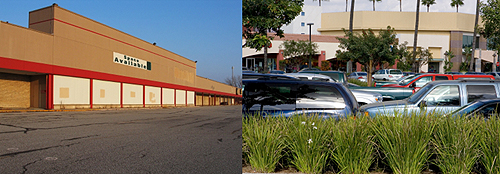
Photos: left - Clay Blackburn. Right - David Peters
Has this ever happened to you? You are driving down a road and notice that on the right
side of the road there are businesses that seem to be thriving. There are cars
in the parking lot, people moving in and out of their doors; all the signs that
commerce is happening. However, on your left, just across the street from the
thriving commercial center, there are all the signs of failed businesses.
Buildings are for sale or lease. Weeds are growing in the cracks in the sidewalks.
It is deserted.
How can one side of the street be buzzing with life and the
other side is rusting into oblivion? All due respect to my friends in real
estate who are chanting in unison, "location, location, location” but I believe
there is a basic marketing principle at work in these kinds of situations. I
would say that choice has more to do with which side of the street thrives and
which side fails.
Several years ago, I was working with the food service and
hospitality industries when fast food franchises began to move inside gas
stations. The idea of the convenience store along interstate highways expanded
to include a food court. At that time, franchises such as Subway, McDonalds,
Taco Bell and Pizza Hut were opening inside these fueling stations. Here is an
interesting thing that happened. If a convenience store (we’ll call it C-store
#1) was the only store at an interstate exit, and the next exit had three other
C-stores (#2, 3 and 4) with the
same basic offerings, C-stores #2, 3 and 4 would each outsell C-store #1. Even
though #1 had a captive audience and no competition, it would under-perform.
Why? It has to do with perceived choices. If my competition is sitting across the street, the consumer
has the power of choice. You may not be keen on the fact that the customer can choose either you or you competition, but hear me out. They can always choose between you and your competition whether you are across the street or at the next exit. The question is, will you even be considered as a possibility when you are perceived to be the one and only choice? Probably not. When you empower your customers with choices, they are
more likely to spend money with you than when they are left with a single
choice.
Choice is something we have grown very accustomed to in an
affluent capitalist society. In fact, we have become so accustomed to it, we
find it odd when choices are limited or non-existent. Thus, when you allow the
customer to make some decisions about your product, you have a better chance of
making a sale. In the case of C-stores, the more choices there were, the better
everyone did in sales. In fact, in the next generation of C-stores, Yum! Brands
began to put a choice of three restaurants in one store when they paired KFC,
Taco Bell and Pizza Hut. Choice is a powerful marketing tool.
What goes into choice as a marketing tool? Let’s go back to
the left and right side of the road. What caused all of the businesses on the
left to shut down while their counterparts on the right side of the road
thrived? For one, I would say that consumers tend to segment shopping areas
from one another based on their convenience. They don’t see both sides of the
road as one area, but two. If there is any inconvenience to the consumer in an
affluent society, they will pass you by. They can purchase what you have
somewhere else. Convenience is a factor in making choices. This can be pretty
petty too. If I have to sit at a stop light for longer than one minute waiting
to turn into a shopping center, I feel like my time has been violated. If I can
easily maneuver my vehicle into and out of the shops on the right side of the
road, I will choose them over the left side shops. How long will you wait at
the light before you think this is a major inconvenience and choose the other
side of road?
Another
impact of choice is perceived value. In the mind of the consumer, there is a
cognitive value or devaluing of one business over another based on its
neighbors. (Yes, I hear you once again real estate friends!) When the first
business closed its doors on the left side of the road, it had an impact on the
judgments that buyers made about the other businesses surrounding its location.
Choice has been limited by one. Pretty soon, dollars start crossing the street
where choice is plentiful. Limiting choice always devalues a business in the
judgment of the buyer. That is why it is very important to be seen in your
marketplace with other players. You might not be operating a retail operation
in a strip center, but you need to have a presence with your customers in the
arenas where others are seen. If you are perceived to be operating on the right
side of the road, your value as a company goes up. It is all a part of
marketing choice.